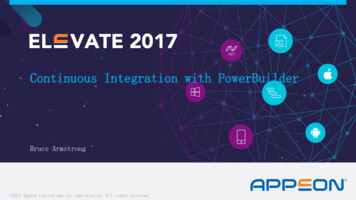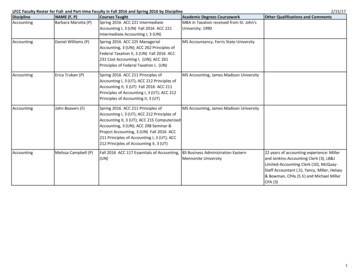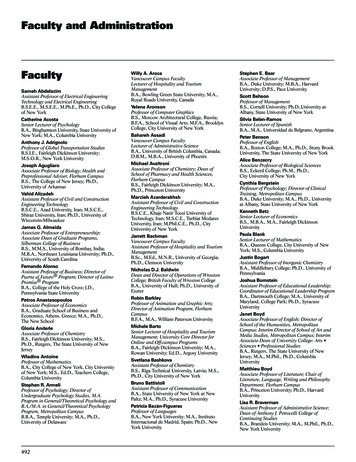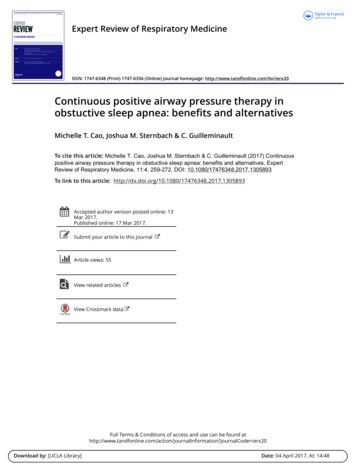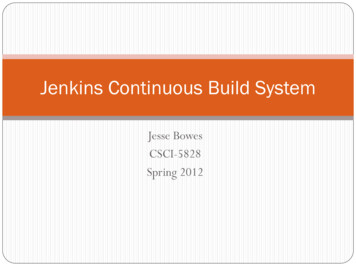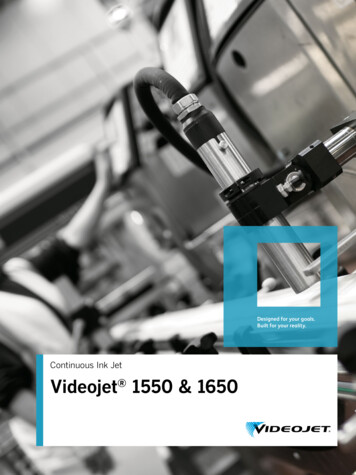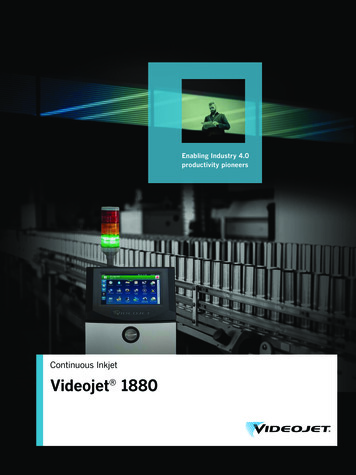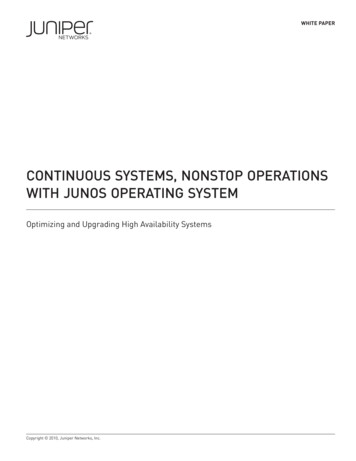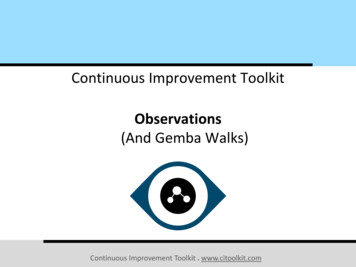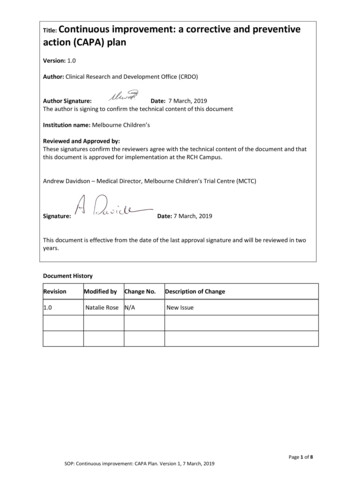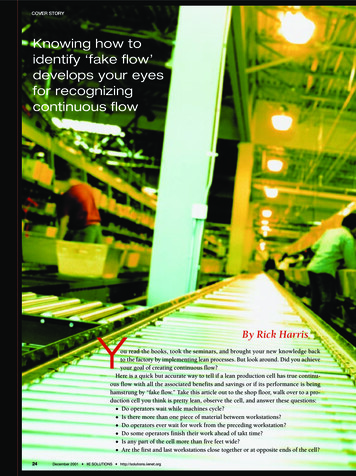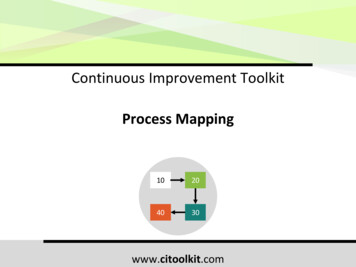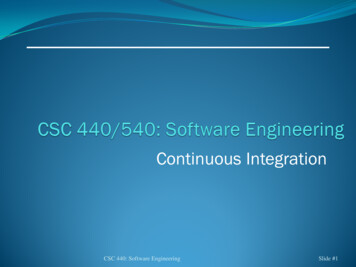
Transcription
Continuous IntegrationCSC 440: Software EngineeringSlide #1
Topics1. Continuous integration2. Configuration management3. Types of version control1. None2. Lock-Modify-Unlock3. Copy-Modify-MergeCSC 440: Software EngineeringSlide #2
What is continuous integration?Continuous Integration (CI) is a development practice thatrequires developers to integrate code into a sharedrepository several times a day. Each check-in is thenverified by an automated build, allowing teams to detectproblems early.CSC 440: Software EngineeringSlide #3
CI ProcessesCSC 440: Software EngineeringSlide #4
If it hurts, do it more oftenCSC 440: Software EngineeringSlide #5
CI Practices Maintain a single source repositoryKeep everything in repository (configuration, docs, etc.)Automate the buildMake your build self-testingEveryone commits to mainline each dayEvery commit should be built (integrated)Keep the build fastTest in a clone of the production environmentMake it easy for anyone to get latest deliverablesEveryone can see results of latest buildAutomate deploymentCSC 440: Software EngineeringSlide #6
CI Benefits Errors are found faster Fewer errors are encountered Releases become easier Releases are available for QA and comparisons Avoid last minute chaos near release dateCSC 440: Software EngineeringSlide #7
Open Source CI ToolsBuild software based on Version control system commits Scheduled times User request from IDECan build on Multiple hardware configurations Multiple OS and middleware configsNotifies developers about Build failures Test failureshttps://en.wikipedia.org/wiki/Comparison of continuous integration softwareCSC 440: Software EngineeringSlide #8
uous-integration-jenkins-plug-in/
Configuration ManagementConfiguration management refers to the process by whichall artifacts relevant to your project, and the relationshipsbetween them, are stored, retrieved, uniquely identified,and modified.CSC 440: Software EngineeringSlide #10
CM enables developers to Exactly reproduce the application environment,including OS version, patch level, network configuration,middleware, and all configuration files. Easily make incremental changes to any environmentalaspects and deploy those changes to any or alldevelopment, testing, or production machines. View the history of configuration changes, includingwhat the change was, who made the change, when thechange was made, and why the change was made.CSC 440: Software EngineeringSlide #11
Application Configuration How do you represent your configuration information? How do deployment scripts access it (DB, file, LDAP,registry, web service)? How does configuration vary between environments,applications, and versions of applications? Is configuration information such as passwords or keysproperly secured?CSC 440: Software EngineeringSlide #12
Testing Configuration1. Verify all references to external services are usable.1. Are external servers up and reachable?2. Can we communicate with them with needed protocols?2. Test functionality of services.1. Can app retrieve or write information (e.g., login todatabase server and read data from a known table)?CSC 440: Software EngineeringSlide #13
What is Version Control?Recording changes made to a file or set of files. Backups only record a snapshot of a file tree. Version control typically also records metadata: What changes were made Who made the changes Why the changes were madeA version control system is like a time machine, allowingyou to retrieve your file from points in time in the pastCSC 440: Software EngineeringSlide #14
Why Version Control?1.2.3.To enable collaborative editing and sharing of files.To maintain a history of a project, tracking whatchanges were made and who made them.To manage multiple releases of a software project.CSC 440: Software EngineeringSlide #15
Using Version Control Keep absolutely everything in version control Requirements, design docs, build instructions, tests External library versions and locations Configurations: OS, network, application Check in regularly to mainline (master, trunk, etc.) Regularly means at least every work day. Use meaningful commit messages Let’s team members know what to expect. Let’s you track down bugs when they appear later.CSC 440: Software EngineeringSlide #16
TermsRepositoryPlace where systems stores tree of your files, with their revisionhistory.ClientPrograms that connect to repository to read or write these files.Check-inWriting changes to the repositoryCheck-outReading a version of your file set from the repositoryWorking CopyUser’s local copy of the repository, including any changes they havenot yet checked inCSC 440: Software EngineeringSlide #17
No Version ControlProblem: how can two users share files, but not overwriteeach other’s changes User A and User B each read file Spam Both edit the file in their editor User A saves his changes User B saves his changes Result: User B’s version of the file is savedUser A’s changes are lostCSC 440: Software EngineeringSlide #18
Manual Version Control Create copies of each file ordirectory with versionnumbers. Ad-hoc, still doesn’t avoid devsstomping on each others’changes.CSC 440: Software EngineeringSlide #19
Lock-Modify-UnlockSolution: Only let one person modify a file at a time User A locks file Spam User A reads file Spam User B attempts to lock file Spam, but is denied access User A saves his changes User A unlocks file Spam. Result: User A’s changes are saved. User B is prevented from accessing the file.Example: RCSCSC 440: Software EngineeringSlide #20
Lock-Modify-Unlock ProblemsWhat if user A forgets to unlock the file? User B waits til user A returns to office to ask for lock or User B asks Admin to unlock file.What if user A’s and user B’s changes don’t overlap? User A wants to edit top of file, User B the bottom User B has to wait for User A to finishWhat if dependencies exist between multiple files? User A modifies file Spam, User B modifies file Eggs. The class in Spam uses the interface of the class inEggs. What if the changes are incompatible?CSC 440: Software EngineeringSlide #21
Copy-Modify-MergeSolution: copy, modify, then merge changes User A checks out a working copy of Spam User B checks out a working copy of Spam Users A and B edit their own copies User A checks in Spam User B attempts to check in Spam, but receives an outof date error Solution 1: User B tells client to merge changes.Solution 2: Changes conflict (same lines were modified).User B manually merges changes, then tells client thatconflict is resolved.CSC 440: Software EngineeringSlide #22
Copy-Modify-Merge AdvantagesUsers can work in parallel, without waiting Most concurrent changes can be automatically merged Time to resolve conflicts is less than time required to waitfor locksCSC 440: Software EngineeringSlide #23
Centralized vs. Distributed VCCSC 440: Software EngineeringSlide #24
Version Control SoftwareOpen Source SoftwareProprietary Software Arch Bitkeeper CVS IBM Clearcase Git Perforce RCS UNIX SCCS Mercurial MS TFVC SubversionAdditional client software exists for many systems GUI interfaces (WinCVS, tkCVS, tortoiseCVS) Editor integration (emacs, vim) IDE integration (Eclipse, VisualStudio)CSC 440: Software EngineeringSlide #25
Adding Files to a Git Repo1. Stage: Tell git which files constitute a single change.2. Commit: Save change to repository with a descriptivecomment.CSC 440: Software EngineeringSlide #26
Interacting with Remote ReposSlide #27
Git History is NonlinearCSC 440: Software EngineeringSlide #28
References1. Martin Fowler, Continuous nuousIntegration.html, 2006.2. Jez Humble and David Farley, Continuous Delivery,Addison-Wesley Professional, 2010.3. PRQA, Continuous Integration Maturity /continuous-integration-jenkins-plug-in/4. ThoughtWorks, Continuous -integrationCSC 440: Software EngineeringSlide #29
Git RCS Mercurial Subversion Bitkeeper IBM Clearcase Perforce UNIX SCCS MS TFVC . Open Source Software . Proprietary Software . Additional client software exists for many systems GUI interfaces (WinCVS , tkCVS, tortoiseCVS) Editor integration ( emacs, vim)
